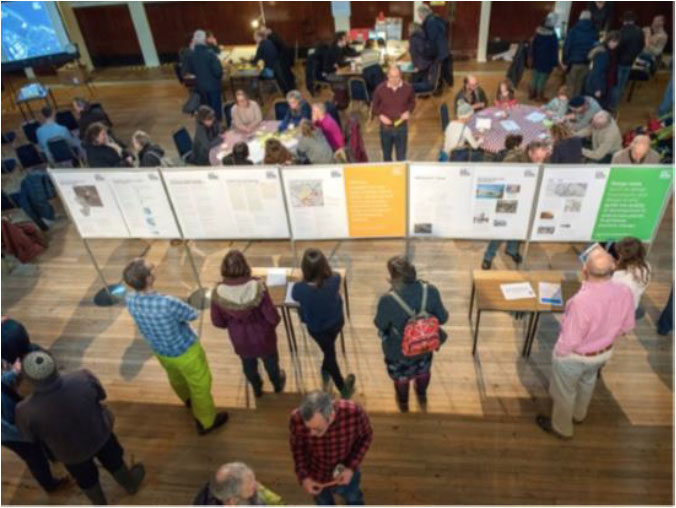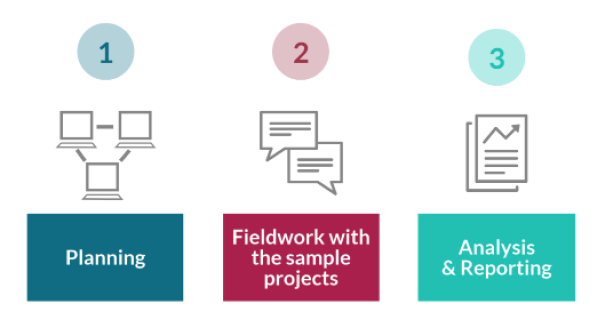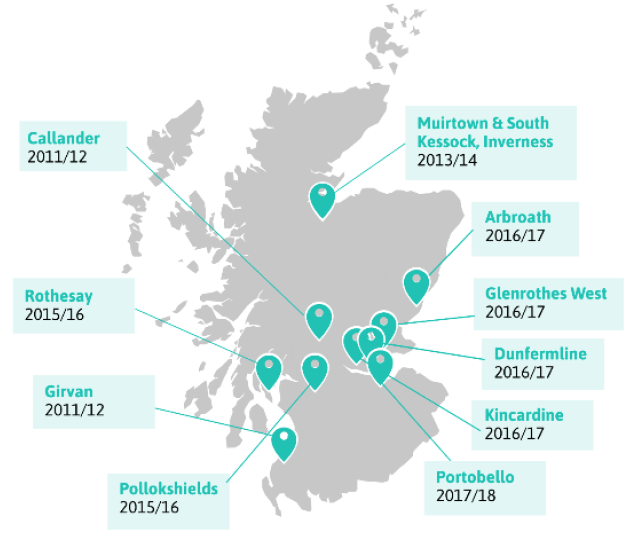Community-led design initiatives: evaluation
Findings from an evaluation of community–led design initiatives funded by the Scottish Government: the Charrette Mainstreaming Programme and the Making Places initiative.
1. Introduction
This report sets out findings from an evaluation of community–led design initiatives funded by the Scottish Government: the Charrette Mainstreaming Programme and the Making Places Initiative. These initiatives are referred to in this report as 'the Programme'.
This chapter provides information about the origins of these initiatives and their policy context, provides an outline of the Programme, and describes the evaluation aims and methodology. Chapter 2 presents an analysis of the projects funded through the Programme.
The findings of the qualitiative research are discussed in the chapters that follow. Chapter 3 discusses the design event processes, including a breakdown by geography and the value of awards. Chapter 4 focuses on impacts and outcomes, covering issues such as impact on physical infrastructure, partnership working and local capacity. Chapter 5 discusses key factors influencing succesful delivery and impact of design events.
Chapter 6 presents conclusions from the research, discussing the findings in relation to the aims of the Programme. Finally, the report identifies eleven key learning points to inform the future development of the Programme.
1.1 Background
1.1.1 Community-led design
The Scottish Government is keen to support the design of places that foster a high quality of life and allow communities to grow and help to challenge inequality. It aims to do so by involving community members in decision-making processes and encouraging them to play a role in shaping the development of their local area. This process has become known as community-led design.
1.1.2 Policy Context
The 2016 independent review of the Scottish planning system called for more community involvement,[1] but the role of communities in shaping public spaces has featured in policy debate in Scotland for some time. The Carnegie UK Trust's (CUKT) 2014 report Places that Love People: Learning from the Carnegie Prize for Design and Wellbeing emphasised the importance of well-designed public spaces and the need for community-led public space improvement to become a priority in town centre regeneration.
Community-led design and regeneration is underpinned by the Community Empowerment (Scotland) Act 2015 (the 2015 Act), which empowered communities through the ownership or control of places and spaces, and strengthened their role in making decisions about public services.[2]
In December 2015, the Scottish Government and partners launched the Place Standard tool to help communities to identify aspects of a place that need to be developed to improve health, wellbeing and quality of life. This tool is used to encourage conversations about the physical and social aspects of a place within a community.[3]
The growing emphasis on community-led design in Scotland is also reflected in Scotland's National Performance Framework (first published in 2007 and updated in 2011 and 2018), which contains indicators around improving people's perceptions of their local area, access to green and blue spaces, influence over local decisions, social capital, and places to interact.[4]
The Scottish Government's commitment to community involvement in design and planning was further confirmed by the development of the Place Principle.[5] This is aligned to the National Performance Framework and aims to encourage better cross-sectoral collaboration and community involvement in the development of places designed to support sustainable and inclusive economic growth. It states that "all those responsible for providing services and looking after assets in a place need to work and plan together, and with local communities, to improve the lives of people, support inclusive and sustainable economic growth and create more successful places". The Place Principle factsheet published by Scottish Government includes examples of tools, resources and applications that can help achieve this, including the Place Standard, the USP Your Town Audit, the Planning for Place programme at the Improvement Service and Scotland's Centre for Regional Inclusive Growth (SCRIG).[6]
As noted in Delivering for Today, Investing for Tomorrow: The Government's Programme for Scotland 2018-19, the Planning (Scotland) Bill of 2017 was introduced to provide confidence for communities and investors involved in planning. Under the current programme, the Scottish Government has committed to expanding its support for community-led design, using the Place Standard tool to ensure that communities are key to shaping developments in their local area from an early stage.[7]
The Planning Bill, recently passed by the Scottish Government, aims to update and streamline Scotland's town planning system. One of the Bill's key features is the introduction of Local Place Plans (LPPs) in order to improve community involvement in the planning system. The Bill enables local communities to prepare an LPP, which is a proposal on the development or use of land. A Community Council or another community body as defined by the 2015 Community Empowerment Act will have the power to produce an LPP, and the planning authority must take this into account when preparing or reviewing the LDP.[8]
These policy developments align with the aims of the Programme which supports communities to engage in design and planning in their local area. The Programme, which is described in the next section, comprises a number of funds which have evolved in response to need.
Community participation in the design process, Portobello charrette

Photo credit: Action Westbank Team
1.1.3 The Programme
The Programme has its roots in the Scottish Sustainable Communities Initiative which was set up in 2008 to encourage the design of places which foster a high quality of life and to support a vision-led approach by project teams in designing a built environment. Through the SSCI Charrette Series which ran in 2010, three projects in Ladyfield (Dumfries), Lochgelly and Grandhome (Aberdeen) enabled the public to participate in interactive design workshops with local professionals and stakeholders to produce a masterplan.[9]
Following the Charrette Series pilot, the Charrette Mainstreaming Programme was set up in 2011 to encourage local communities to play an active role in the development of their local area by participating in the design process.[10]
Aimed at local authorities and public bodies initially, the programme funded design charrettes that supported the production of local development plans (LDPs).
In 2013-14 the fund was split into two streams, one continuing to support the development of LDPs and a second, open to communities, third sector groups and local authorities to fund charrettes in support of town centre regeneration. In 2015-16 these streams were consolidated into a single fund for communities, local authorities and third sector organisations to access support for charrettes covering a wide range of issues, including linking spatial and community planning outcomes.
It was recognised that communities may need support not only in creating a vision for their area, but before and after they reach this stage as well. It was also recognised that large-scale charrette style design events may not be appropriate for community groups that do not have the capacity or confidence to undertake a design event. As a result, in 2016-17, the Charrette Mainstreaming Programme was broadened into the Making Places Initiative, which supported a wider variety of participative design events than charrettes, including smaller workshops.[11]
Distributing over £1.4 million in funding, the Scottish Government assisted 78 design events through the Programme between 2011 and 2018, enabling communities to develop ideas about the future of their local area. The key aims of the Programme at present are to:
- develop an effective method of design which focuses on 'place' and outcomes for local communities
- encourage the mainstreaming of creative design processes in community planning
- place local communities at the centre of the design process
- foster collaborative working between public sector organisations and local communities
The Programme's funding award process is a competitive one. Organisations wishing to apply for funding must submit an application form evidencing how their project will engage local people in the process, combat inequalities and disadvantage and make a difference to the local area, as well as outline how any actions from funded events will be taken forward.
Applications are considered by assessment panels. Until 2015-16, all assessment was completed by Scottish Government staff. However, with an increased emphasis on community-led projects, it was decided to bring in external partners with expertise in either working with communities, design events or other grant award processes to take part in the assessment process. External assessors have been provided by the Scottish Community Alliance, the Scottish Community Development Centre, COSLA, Big Lottery Fund and the University of Dundee. A new panel has been formed each year and panellists are required to confirm they have no conflict of interest in the process due to (in some cases) their close working relationships with communities.
1.2 Aims of the evaluation
In February 2019, the Scottish Government commissioned Blake Stevenson Limited working with Watson Burnett Architects to undertake an evaluation of the Programme.
Although many design events have been funded through the Programme to date and final reports describing the immediate outcomes of these processes were submitted to Scottish Government, no cross-cutting evaluation has been conducted to date that explores the success of these events in empowering local communities to develop ideas about the future of their local area.
There was also a desire on the part of Scottish Government to find out whether outputs from funded community-led design events had been implemented within local communities and, if they had been, what had been achieved.
The aims of the evaluation were to:
- assess whether and how the Programme has succeeded in achieving its aims to date
- assess the impact and outcomes of funded design events at a local level
- explore whether/how outputs (e.g. action plans) have been implemented
- create learning about the impact of the Programme that can be used to inform its future development, such as funding decisions
Three key research questions were developed for the evaluation:
- how effective are the design processes in encouraging and empowering local communities' involvement in the design of places?
- what factors influence the implementation of outputs?
- what has been achieved through these design events in terms of longer-term outcomes for communities and partners?
1.3 Evaluation methodology
The evaluation was overseen by a Research Advisory Group (RAG) which met twice during the study – at the outset, following the inception meeting, and at the end to discuss the draft final report. As shown in Figure 1.1, the evaluation involved three key phases.
Figure 1.1 Three phases of evaluation

1.3.1 Phase 1: Planning
The first stage of the evaluation involved an inception meeting, which provided the opportunity to clarify the aims and priorities of the research. Following the inception meeting, the team undertook desk-based research, involving a review of project-related documentation such as application forms and design event reports.
The evaluation activity focused on ten completed projects from across Scotland. The following criteria guided the selection:
- funding initiative and year in which design events took place (to ensure that progress was examined in areas where the design events had taken place recently and less recently)
- geography
- urban/rural locations
- socio-economic profile of areas
- event facilitators (to ensure that design events facilitated by a wide range of organisations were examined)
- type of activity
- level of funding received
On the basis of these criteria, the 10 projects selected to be part of the study were:
- Girvan
- Kindcardine
- Dunfermline
- Portobello, Edinburgh
- Muirtown & South Kessock, Inverness
- Arbroath
- Rothesay
- Callander
- Pollokshields, Glasgow
- Glenrothes West
Figure 1.2 on the following page shows the location of the projects.
Figure 1.2: Sample projects

During this initial phase the research team undertook a series of fact-finding calls with stakeholders from each of the sample projects.
Blake Stevenson also hosted a workshop involving a selection of facilitators from across Scotland, most of whom had been involved in multiple design event processes. This workshop was an opportunity to discuss their experiences of design events more widely, and their input informed the development of research tools for the fieldwork phase.
1.3.2 Phase 2: Fieldwork with the sample projects
The evaluation activity involved visits and fieldwork with each of the sample projects. Researchers interviewed representatives from the local area including the key delivery partner, the design event facilitators, local authority officers, and a range of individuals from the community.
The aims of the visits and the follow-up phone calls were to:
- gain a fuller understanding of the processes involved in organising the design events, the purpose of these in each area, and the numbers and range of people attending
- assess the impact of the funded design events locally and what outcomes were achieved at the time or subsequently
- understand how outputs have been implemented since the events, the extent of involvement of those interviewed, and the extent to which this is an ongoing process
- explore factors which affected implementation of outputs, any facilitators or constraints, and lessons learned
- explore the extent to which participants/members of the community were empowered by the design processes and have continued to be engaged in the processes since the design events
1.3.3 Phase 3: Analysis and Reporting
The fieldwork and desk research generated substantive data from which key themes were extrapolated. These themes were examined in relation to the evaluation aims and objectives, and variations in delivery, outputs and outcomes in each of the areas were examined. During the analysis, examples were selected to illustrate key findings related to the effectiveness of the programme in involving communities, public sector organisations and third sector groups coming together for a design process.
This report presents the findings from the evaluation.
Contact
There is a problem
Thanks for your feedback